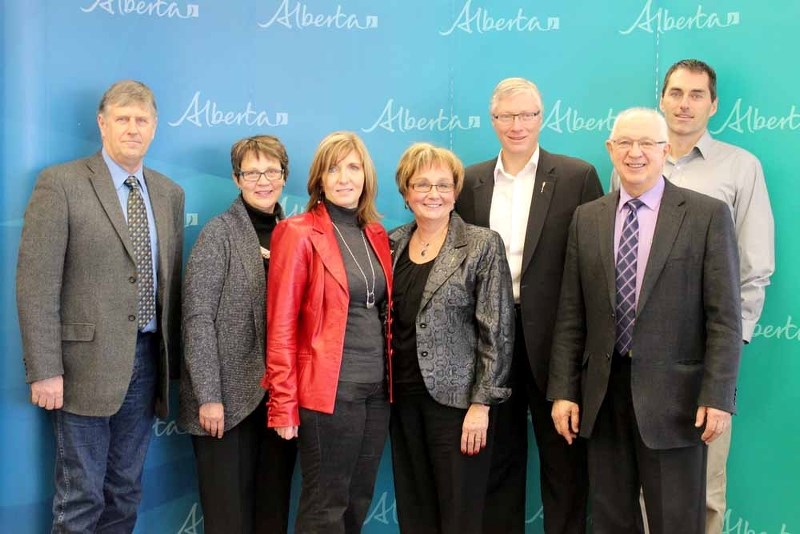Representatives from the County of St. Paul and the M.D. of Bonnyville met with Minister of Agriculture and Rural Development Verlyn Olson at St. Paul’s provincial building on Friday to announce over $1.2 million in grants for the Final Mile Rural Community Program.
Four communities in northern Alberta, the County of St. Paul, the M.D. of Bonnyville, Lac La Biche County and Fishing Lake Metis Settlement, will see over $1.2 million in grants through the Final Mile program. Collectively, the project will see 28 new towers constructed, including one co-location site.
County of St. Paul Reeve Steve Upham spoke of the importance of the Final Mile program at Friday’s announcement, which will see nine towers built within the County of St. Paul, nine within the M.D. of Bonnyville, eight in Lac La Biche and two in Fishing Lake.
“The (Final Mile) program an extremely important initiative that provides for the completion of a comprehensive communication network, ensuring high-speed Internet access to all residents across this region,” said Upham, adding that the infrastructure should be in place by March of 2014. “The continued growth of business development in the northeast or Lakeland area is unequaled anywhere else in the province. Uncompromised high-speed access is a non-negotiable requirement for ag producers, rural based businesses and service industries based in remote locations.”
St. Paul county has received a grant of $341,250, while the M.D. of Bonnyville received $399,750, Lac La Biche was given $274,080 and Fishing Lake received $211,500.
Bonnyville-Cold Lake MLA Genia Leskiw also shared her belief that expanding high-speed Internet access is important in achieving rural development.
“Sustainable growth and rural development are priorities for our government, and we see technology and innovation at the heart of that development,” said Leskiw. “Technology has made the world a smaller place and expands opportunities for growth to a global stage. Today’s announcement is a part of how our government is supporting our priorities in sustainable growth and rural development.”
The Final Mile Rural Community Program is a partnership between Agriculture and Rural Development and Service Alberta. The program is investing over $5 million in 23 projects that will see expanded high-speed Internet service across the province, according to a press release from the Government of Alberta.
Olson pointed out that the Final Mile program has a goal of providing high-speed Internet access to at least 98 per cent of Albertans, which it is currently aimed at achieving.
“No matter where you live in Alberta, there are certain things that you should be entitled to as an Albertan and one is this connectivity. It’s absolutely crucial for the lifeblood of rural Alberta,” said Olson. “Whether it’s students doing their homework, a farmer checking the weather or global prices, or whether it’s somebody who just wants to keep track of their family members on the other side of the world, the Internet really is the tool. It’s a piece of infrastructure that is really very important.”
Minister of Service Alberta Manmeet Bhullar appeared at Friday’s announcement via videoconference from Calgary to declare that the Final Mile goal of providing 98 per cent of Albertans with high-speed Internet access has been achieved.
“I’m so proud to announce the successful completion of our target. We have in fact surpassed it . . . we are able to announce that 98.3 per cent of Albertans will now have access to high-speed Internet,” said Bhullar. “This isn’t about just technology. It’s about how technology affects people’s lives; how it makes their lives better and allows them to connect with people, allows them to learn, allows them to access government services.”
Bhullar added that he feels access to high-speed Internet is crucial to family life in Alberta
“Reliable high-speed internet is essential to families. Whether you’re accessing government services, or if you want to jump on Netflix or connect with your families on Facebook, these are essential ways for people to connect,” he said. “To think that there were some folks in remote areas that didn’t have access to that technology, and now through a lot of our efforts, we’ve been able to help make that happen.”
Olson went on to point out the potential impact expanded high-speed Internet access could have on small business in rural Alberta.
“I think it’s going to have a huge potential impact for small business. That’s one of the things that we’re pushing. When we talk about building Alberta, we talk about access to markets as well as living within our means and supporting families and communities,” said Olson. “When you talk about access to markets, we tend to think that foreign markets are only reached by big companies in big cities . . . People need to get their head around the idea that you don’t have to be in a big city to, for example, sell honey to Japan.”
Of the nine towers to be built within the County of St. Paul, CAO Shiela Kitz said that some will be built in the northern area of the county, while several will be constructed in the southeast.
M.D. of Bonnyville CAO Ryan Poole explained that the M.D. highlighted certain areas to ensure that the nine towers would be evenly spread out to provide the greatest coverage possible.
“In the MD of Bonnyville it’s actually pretty evenly spread out. We filled in a bunch of holes where there were more remote dead spots and low areas that still had a fairly large population,” said Poole. “It’s spread out, kind of dotted all over our map.”



